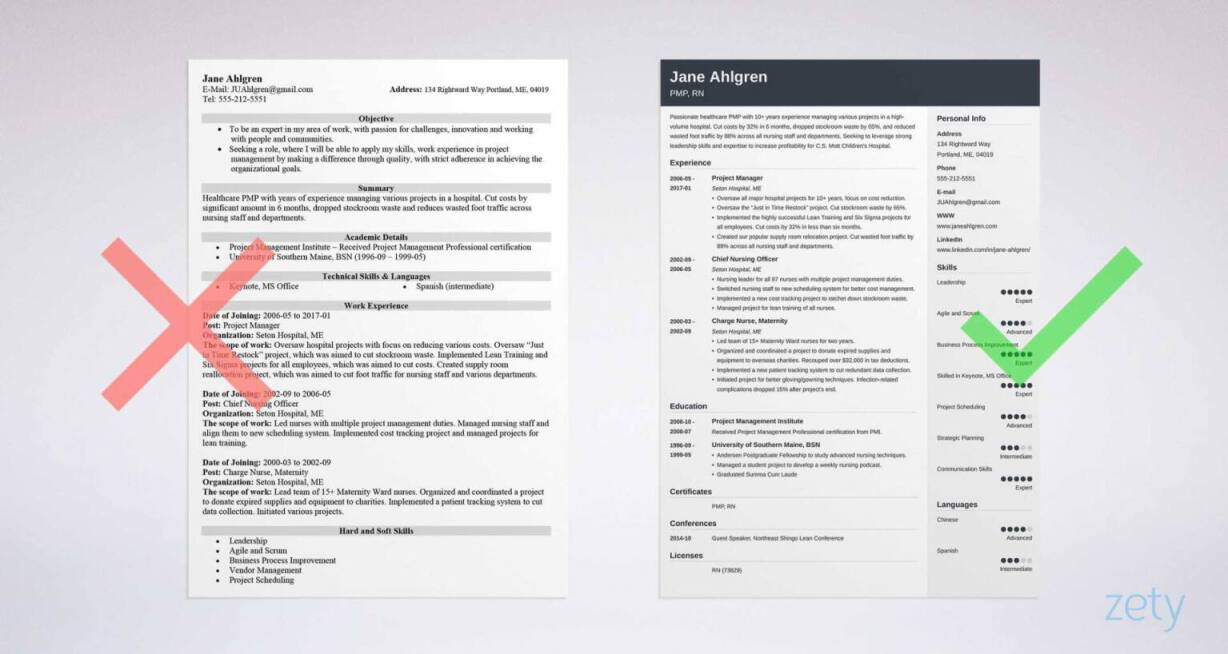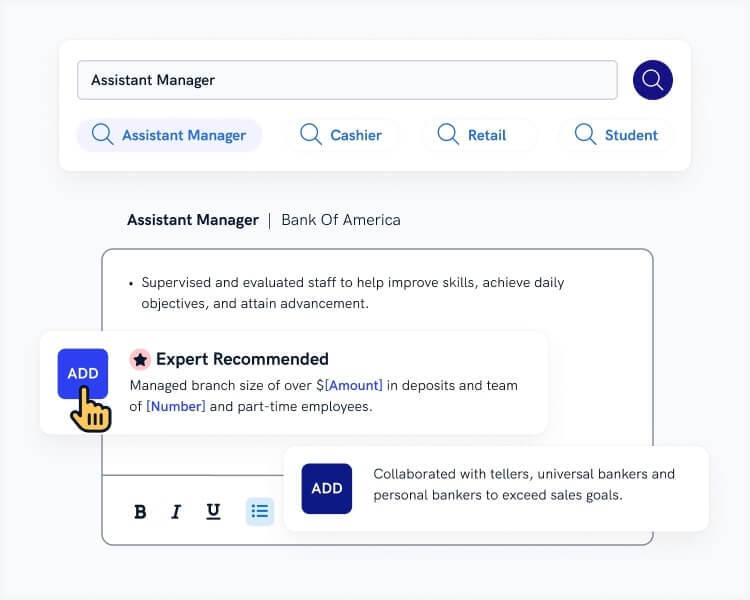Best CV Structure: How to Set out a Perfect CV
Create your CV nowWe all have different experiences and skills. Different strengths and weaknesses. We’re at different stages of our career and targeting completely different jobs. So you wouldn’t think there’s one common thread linking every job seeker.
But there is.
And it’s making sure you use the correct CV structure. The same basic CV structure can be used as the base on which to build a curriculum vitae unique to you. But everyone needs to start with the same solid foundation to create a job-winning CV.
Here’s how to do it.
Want to save time and have your CV ready in 5 minutes? Try our CV builder. It’s fast and easy to use. Plus, you’ll get ready-made content to add with one click. See 20+ CV templates and create your CV here.
Sample CV made with our builder—See more CV examples here.
This guide sets out a basic framework for your CV. If you want a more detailed CV writing guide then read more here: How to Write a CV: Professional UK Examples
How to Structure a CV Step by Step
Chronological CV structure is the gold standard of CV writing and the structure most preferred by recruiters. Its main focus is your work experience, the single most relevant factor for most jobs.
Plus, it’s easy to read and lets busy hiring managers quickly scan your CV and zone in on the information they need. It’s also fully compatible with ATS software.
A chronological CV structure should contain the following sections.
- CV header containing your name and contact details.
- CV personal profile acting as an introduction to your strengths as a candidate.
- Work experience section containing your professional history.
- Education section.
- Skills section tailored to the job you’re applying for.
- Relevant additional sections to make your CV stand out.
Let’s go through each section in turn.
1. Add a CV Header
Start with your full name written in a CV font 4–6 points bigger than your body text to make it stand out. Then include your phone number, email address, LinkedIn profile and any relevant social media handles. No need for your postal address, it just wastes space.
2. Write a CV Personal Profile
In 3–4 sentences, grab the hiring manager’s attention by stating who you are, what you can offer to the employer and what your career goals are. This section is easier to write if you leave it until last. That way you’ve already got your work experience, education and skills ready to refer to.
Read more: How to Write a CV Personal Profile: Examples of CV Personal Statements
3. Create a Work Experience Section
Add your most recent job first and then work back from there. Include the name of the employer, your job title and your dates of employment. Write up to six bullet points for each role, starting with punchy action words for impact and using accomplishment statements for good CV structure.
4. Add Education
If you’re a fresh graduate or school-leaver you can put this section before your work experience.
- For school leavers, include your A-level subjects and for your GCSEs you only need mention Maths and English specifically. These are a bare minimum requirement for many employers.
- For university graduates include the name of the university, the degree you obtained and the dates you pursued it. For postgraduate degrees list the most recent first and work back in reverse chronological order.
5. List Skills
Tailor your skills to the job by matching them up to what’s described in the job advert. Always try to ensure that 3–4 of the skills you list on your CV match what’s required by the employer.
Aim for a mix of hard, soft and technical skills and don’t just list them. Include a brief statement for each that demonstrates your competency in that skill. E.g. Complaint resolution: de-escalated challenging situations and resolved majority of complaints at first point of contact.
Read more: Key Skills to Put on a CV: Best List of Top Skills
6. Consider Additional Sections
Technically, you’d have the right CV structure if you finished with your skills section. But if you really want to impress recruiters and stand out as a candidate you need to add additional sections.
There are plenty of options, choose one that’s representative of your own circumstances and is a good match to the job you’re targeting. Examples of additional sections include languages, projects, hobbies and interests, volunteering and awards.
Languages and volunteering are particularly powerful choices. Being bilingual improves your job prospects and 82% of managers prefer to hire candidates with volunteering experience.
Read more: Best Hobbies & Interests to Put on a CV
Making a CV with our builder is incredibly simple. Follow our step-by-step guide, use ready-made content tailored to your job and have a CV ready in minutes.
When you’re done, Zety’s CV builder will score your CV and tell you exactly how to make it better.
Other Types of CV Structure
There is one other type of CV structure used in the UK. It’s called skills-based or functional format. It can only be used successfully by a minority of candidates. If you have any doubts, stick with Chronological. Here’s the sort of job seekers it can work for:
- Career changers and candidates with no experience.
- Ex-military personnel transitioning to work in the civilian sector.
- Project-based and gig economy workers with a limited history of permanent long-term employment.
And this is how a skills-based CV is structured.
A skills-based CV structure should contain the following sections.
- CV header
- CV personal profile
- Skills summary with detailed information on your mastery of relevant skills
- Work experience
- Education
- Additional sections
A skills-based CV is written in the same way as a chronological structure, except for the skills and work experience sections. The spotlight shifts from your professional history to your transferable skills. Here’s how it’s done.
- Write a master list containing all of your skills. Be sure to include soft skills, hard skills and technical skills.
- Analyse the job description in the job advert and list what skills are needed.
- Select 3–4 of your skills that match those required for the job and list them in your skills summary as subheadings, e.g. Web Design.
- Under each subheading include 2–5 bullet points that show your competence in this skill.
- Start your bullet points with action words and structure them with accomplishment statements.
With the focus on your skills summary, your work experience section should be shorter than on a chronological CV. So you can either leave out the descriptive bullet points altogether, or if necessary write 2–3 brief bullet points listing key responsibilities and accomplishments.
Read more: Skills Based CV Template: Writing Guide with Examples
How to Structure a CV—Layout
The structure of a CV is nothing without a good layout. If the CV sections paint the picture then the layout is your frame. Here’s what you need to do.
- Set your margins to one inch on each side of the page. This frames your content with plenty of white space for maximum readability.
- Choose a good CV font, like Calibri or Helvetica, and set the size to 11–12 pt.
- Save your CV in PDF format unless specified otherwise. It’s the best format for keeping your layout intact.
- Keep it concise. The best CV length is no more than 2 pages.
Read more: CV Layout: How to Lay out a Professional CV
Plus, a great cover letter that matches your CV will give you an advantage over other candidates. You can write it in our cover letter builder here. Here's what it may look like:
See more cover letter templates and start writing.
Key Takeaways
Here’s how to structure a CV:
- Choose chronological CV structure to focus on your professional experience. It’s the best CV structure for most candidates.
- Use skills-based CV structure if you’re a military transitioner, career changer or have no experience, but take care and make sure your skills summary is relevant and well written.
- For both types of UK CV structure, set out your sections in the correct order. And—
- Cement your good CV structure in place with a well-arranged layout.
And we’re done, that’s everything you need to know about how to structure a CV. Thanks for reading.
About Zety’s Editorial Process
Our editorial team has thoroughly reviewed this article to ensure it follows Zety’s editorial guidelines. Our dedication lies in sharing our expertise and providing you with actionable career advice that offers you real value. Every year, the quality of our content attracts 40 million readers to our site. But that’s not all – we conduct original research to gain a detailed understanding of the labour market. We take pride in being cited by top universities and leading media outlets in the UK and worldwide.






